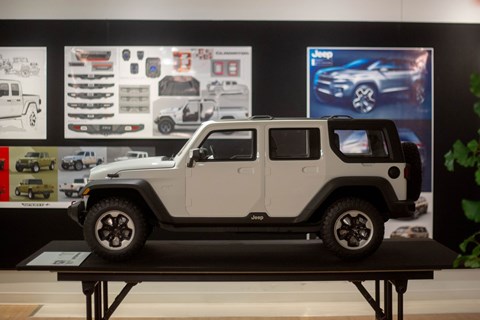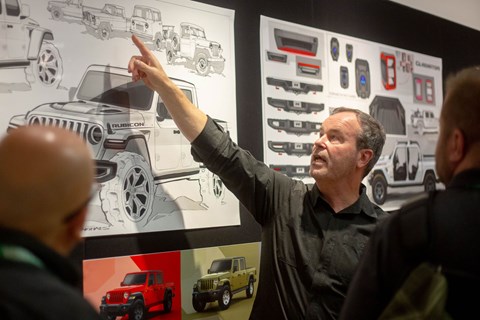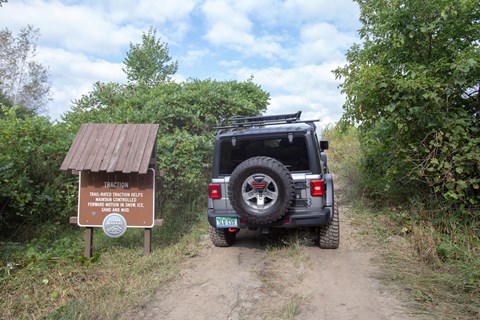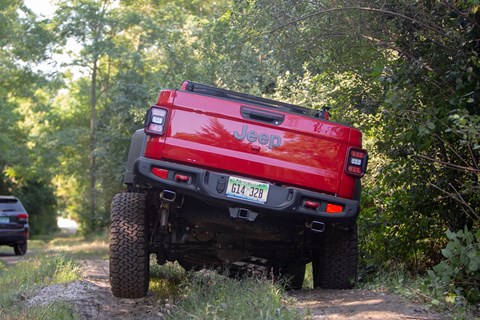► Jeep’s brand DNA explored
► How can it stay Jeep in future?
► Why its off-road heritage is important
Jeep is a funny brand from a UK perspective; we have a little trouble taking it seriously. Its products have a slightly try-hard image; on the one hand it seems to build wannabe Range Rover rivals with interiors that we find filled with just a bit too much American chintz, on the other it persists with producing cartoonishly authentic off-roaders that seem out of step with modern concepts of sophistication and perhaps even taste.
But this also appears to be a curiously British problem. Speaking to some of the movers and shakers behind the brand, and although they continue to draw strength from a kind of underdog spirit, they’re also deeply proud – with good reason – that globally Jeep is one of the big success stories within the FCA portfolio of car companies. In 2009, Jeep sold just 300,000 vehicles; in 2018 it was 1.6 million, and the firm has expanded from four USA-based factories to 10 plants in six countries.
The compact Renegade has played a major role in this growth since its introduction in 2014, and it’s presumably no coincidence that this is a very different kind of product to a traditional Jeep – being small and based on a front-wheel drive platform borrowed from Fiat. But with its quirky, characterful design, populated by well-documented Easter egg features, the Renegade also manages to be Jeep distilled, and its four-wheel drive versions have genuine capability.
As such, it’s a defining example of the trick that Jeep needs to keep on pulling off if it wants to survive in a world where buyer expectation of sophistication is set at a base level far higher than Jeep has traditionally operated at, and where character is key to standing out from the crowd.
Hence the unusual opportunity we’ve been given to not only visit Jeep’s renowned Chelsea Proving Grounds development centre but also its top-secret ‘Area 51’ design studio as well.
What is this secret lab and why should I care?
‘Area 51’ is the pet name for Jeep’s design base, a small studio space enclosed within FCA’s vast North American headquarters that’s located in the Auburn Hills region of Detroit.
The team there, led by head of Jeep design, Mark Allen, is just in the process of ‘putting the bow on’ the next Grand Cherokee, while simultaneously wrestling with how best to deal with the high-tech ‘user experience’ (UX) revolution that was probably started by Tesla but is currently being supercharged by automotive manufacturers in China and warped by the disruptive influence of Apple and Google.
If the idea was to really convince us that it has some totally top flight solutions to keeping passengers entertained in the near future, Jeep mildly bungled it. Instead of showing us something genuinely new we were treated to a few heavy hints and an interesting but not especially enlightening discussion of the current UX predicament.

This last was done with reference to the Jeep Yunto concept that was shown in China back in 2017 from chief interior designer Chris Benjamin, and some insight into the disruptive influence of tech from UX guru Vince Galanta. We didn’t even see a picture of the Grand Cherokee.
For those who can’t recall it, the Yunto is a seven-seater that aims to dazzle and delight its occupants with no less than 11 screens, one of those light and floaty interior themes and a set of standard show-car back-to-front doors.
It ticks all the right boxes, but apart from a few design cues – hard buttons that ape the traditional seven-bar Jeep grille, for example – doesn’t do much to set Jeep aside from anyone else concept car-ing in the same way. In fact, compared with the Nomi AI assistant that Chinese electric carmaker Nio is already experimenting with in production, the Yunto is probably already out of date. Something that Jeep seemed to acknowledge by bringing Nomi up.
So how is Jeep planning to stand out?
Well, although it’s playing its cards close to its chest, there’s a clear two-pronged approach here for Jeep.
Firstly, it will have to match rivals tech-for-tech – as Allen said repeatedly, ‘If you don’t get this right now, you are done.’
As such, it’s no accident that the team working on the next-generation user experience is located within the design department. Nor should we be surprised by Galanta’s colleagues including people who have worked in the video games industry – about which more in a moment.
Secondly, Jeep will need to continue to successfully leverage its heritage. This is not just about age and design – its origins in 1941 make it nearly 80 years old in 2019, but they also laid the foundations for the thing that lies at the very core of every Jeep model ever since: the promise of the ability to go anywhere.
This would seem to become a – conscious or subconscious, who cares – mechanical embodiment of freedom to many Jeep buyers.

It doesn’t matter that the vast majority don’t ever take their Jeeps further off-road than the nearest pavement; it’s the reassurance that they could that is surely key to Jeep maintaining its identity and its appeal as technology continues to homogenise the automotive experience.
It’s also what makes Jeep different to Land Rover, I feel. Land Rovers and Range Rovers remain outstandingly impressive off-road machines, but they are now at least as much associated with prestige and luxury. Land Rover could build a luxury vehicle with no off-road pretensions at all at this point, and hardly anyone would bat an eyelid. Jeep buyers, you sense, would still demand off-road authenticity.
Which is where the Chelsea Proving Ground and ‘Trail Rated’ badging comes in.
How does Jeep develop for off-road capability?
At CPG we meet Bernie Trautmann, Jeep’s ‘off-road development lead’. This is the man ultimately responsible for the off-road performance of every Jeep model, and he explains that it doesn’t come about by accident.
Rather, at this point in time, Jeep’s ‘currency of capability’ is the product of a very specific process, especially when it comes to the Trail Rated variants, which range from the Renegade Trailhawk to the Wrangler and Gladiator Rubicon models. As well as subjective input from the development drivers, this process involves objective metrics and algorithms, covering five main categories: Traction, Water Fording, Ground Clearance, Manoeuvrability and Articulation.

For the most part these are self-explanatory, although there are some interesting details. Traction, for instance, covers tyre performance including aggressive off-road tread patterns, something called ‘crawl ratio’, and what’s referred to as ‘tractive effort’.
Crawl ratio is maths, combining first gear with the transfer case and the axle ratio; the higher the numbers the greater and more controllable the low speed torque application. The Wrangler and Gladiator Rubicons with a manual transmission have a crawl ratio of 84.2:1 using their low ratio gearing, a figure massively higher than the next best model in even the Jeep range (the Cherokee at 51.2:1). This means they not only have enough torque at zero throttle application to get rolling, but that the driver barely has to touch the accelerator to tackle a wide range of off-road obstacles.
Tractive effort, meanwhile, refers to the tech that keeps the torque ‘on the ground’ – which is to say what transfers it to the wheels with ground contact in extreme situations. How extreme being dictated by the level of Articulation offered by the vehicle.
This tech can be mechanical – the physical locking differentials used in the Wrangler and Gladiator Rubicons – or electronic in the form of the Brake Limited Differential (BLD) system fitted on every model, including the Wranger and Gladiator. BLD uses the ABS sensors to divert torque across the axle to the wheel with grip rather than a big set of cogs.
Which is better – mechanical or electronic?
Trautmann is pretty frank about this: ’10 years ago, mechanical was better hands down. Now with BLD the electronics have caught right up – the speed of response is such that it’s almost at mechanical level.’
We’ve sampled both over the same obstacles. He’s not kidding.
For most buyers this is enough – it’s less about the means of deploying the capability at this point, and more about ensuring that this capability remains present and correct.
Yet it seems a core component of the Jeep customer base, and evidently its personnel, still demands a fully authentic experience. Which continues to be embraced and embodied by the Wrangler, and its recent pick-up truck offshoot, the Gladiator.
Is the Wrangler really that different to other off-roaders?
These don’t just look old school, they continue to use a physical lever rather than electronic controls to engage their four-wheel drive systems – a macho procedure that verges on the arcane, as the lever requires the vehicle to be moving in neutral before it will allow you to shift it. Say what?
Yet, they aren’t total throwbacks. The top spec Rubicon versions not only feature electronic switches for their front and rear locking differentials but also a ‘smart’ anti-roll bar that can be disengaged and reengaged at the press of a button, maximising axle articulation when required while making sure you don’t flip over at the first sight of a fast turn when you’re back on the tarmac.
Authenticity is important, but capability is key. As Trautmann explains this isn’t just posturing; for him, others at Jeep and their most committed customers, there is a practical function – to get further up the trail, down the river or into the woods, for hunting and fishing, and all that outdoorsy stuff.
Hence the wide selection of Mopar accessories available to further improve its performance.

Highlights on the Rubicons driven at CPG include an official two-inch lift kit, upgraded wheels with monster 37-inch tyres, fearsomely bright LED auxiliary lights, and on the Gladiator a set of tube doors – though we spot plenty of drivers happily purring along the highway without them. Or anything else for that matter.
For there’s more mythos in the Wrangler’s design. It has to have removable doors, it has to have removable roof panels and it has to have a fold-flat windscreen – in addition to the boxy trademark looks.
This latest model, the JL (the Gladiator is the JT), was introduced in the 2018 but could stand in for any number of previous generations, and Allen says he doesn’t mind if people can’t tell which it is from a block away. A consciously evolutionary approach that he equates with the Porsche 911. Seriously.
They are good off-road right?
The Chelsea Proving Ground has been operational since 1954, and the Lyman Trail is one of the oldest off-road routes. It is supposed to showcase each of those five traits listed above, but by most standards these days it is comparatively tame. (There is a Trautmann Trail at CPG now; apparently that’s quite difficult.)
Even so, effortlessly able though these Rubicon models are, they still require input from the driver. A guy ahead gets the Wrangler temporarily jammed-up on a stepped climb, while others pound through off-set bumps with zero indication of mechanical sympathy. The Wrangler eats it up, but moving slower is a better demonstration of the extent of articulation on offer, the crawl ratio, the sheer tractability.
On the other hand, the least metrically capable Trail Rated Jeep, the Renegade, is out on the Lyman too, and walks it. While the aged challenge of this particular route plays its part in this, there is a scampering tenacity to the little Trailhawk that speaks of its hard-won and – yes – authentic ability. And it puts a grin on the face of everyone who tries it.

What about those heavy UX hints you mentioned?
While nothing is confirmed at this stage, the topics of presentation may be telling.
Benjamin talks of screens with shareable content, so passengers can send what they’re viewing – and it is inevitably viewing now, not just listening – around the car to the people with them. The art of conversation is holding its head in its hands.
Galanta references the goal-orientated behaviour of modern (that is to say: young) media users, and the level of graphical detail they’ve become used to through racing simulators and the like.
This is not just about looking slick – which of course is now a must have component of any infotainment system. If you can fully customise the appearance of a car in a smartphone app, people are beginning to wonder why you can’t do the same in the menu system for your actual car.
Hence the relevance of gaming programmers for Jeep in the next-generation of UX capability. The details have now not only got to be right but at a level of sophistication that far surpasses previous efforts.
The Mopar thing speaks of the importance of personalisation, too, American carmakers have understood the desire for an in-house alternative to aftermarket hop-up parts for decades. But with every carmaker now tapping into that psyche, again you’re left wondering how anyone stands out.
Jeep may still have a head start, thanks to its customers’ sense of community; the ‘Jeep wave’ might seem trite and even kitsch, not to mention a gesture of acknowledgement that’s hardly unique to this brand, but it does exist, and further hints suggest it could be built on – with technology.
Participating in a digital community will be nothing new for some people – examples run from Twitter to Pokémon Go – but to be able to participate via your car is at least different. And Jeep can successfully leverage that aspect of its buyers preferences it will surely only solidify its future appeal.
Check out our Jeep reviews